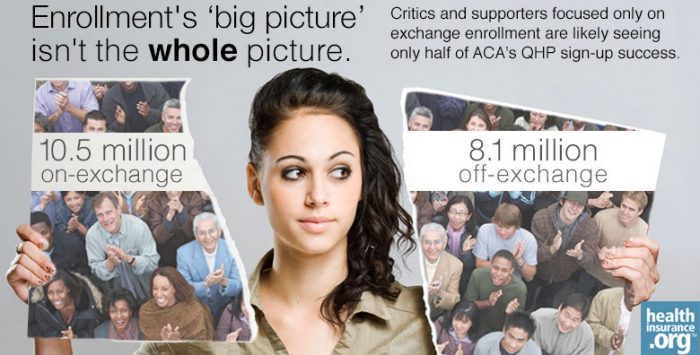UPDATE: I noted below that 55 percent of Washington State’s QHPs were off-exchange last spring. I’ve learned today that this was still the case as of late November.
Last spring I was shouting from the rooftops about off-exchange QHP enrollments at a time when most reporters (and especially ACA opponents) seemed to be under the impression that ACA’s exchanges were the only game in town when it came to individual/family healthcare policies. Apparently, they thought that starting on Jan. 1, 2014, no one was allowed to simply call up Blue Cross, Aetna, etc. directly and sign up for a private policy without running it through the Obamacare web sites.
In fairness, there are two exchanges where this situation did go into effect: The District of Columbia (which started requiring this out of concern that their exchange pool wouldn’t be large enough otherwise) and Vermont (which did so for the same reason, in addition to being part of their ongoing move towards Single Payer … although that larger move has unfortunately been put on hold in recent days).
In every other state, however, plenty of people are bypassing the exchanges altogether and enrolling directly through the insurance companies … and why wouldn’t they? If your income is above the ACA tax credit threshold, there’s very little incentive to jump through those extra hoops, even if the process is much smoother than it was last year.
That’s why only about 15 percent of the exchange-based enrollees fall into this category; everyone else at the higher income threshold just called up a carrier directly.
Off-exchange numbers pooh-poohed
As I noted, prominent ACA opponents such as Avik Roy were pooh-poohing the idea that there were significant numbers of people enrolling in off-exchange, ACA-compliant policies. They claimed that it was “not a big number” and that I was “overstating” the number (and this was back in mid-March, when I had arleady confirmed around 560,000 off-exchange policies out of around 5.6 million on-exchange).
Needless to say, Roy was utterly full of nonsense. I eventually officially confirmed nearly 2.5 million off-exchange QHPs for 2014 from about a third of the states, and institutional estimates for the national total were far higher – a minimum of 5 million according to the CBO, and nearly 8 million according to the RAND Corporation. The RAND number was closer to my own estimates, so that’s what I went with for the rest of the year.
This estimate is also supported by Mark Farrah Associates (thanks to Ken Kelly for the link), which notes that according to the Department of HHS (in the same “ASPE brief” which gave their official target of 9.1 million paying exchange-based QHPs), “In addition to the uninsured, HHS includes an estimated 8 to 12 million people who already have off-Marketplace coverage in the total addressable market.”
Remember, that “8 to 12 million” includes up to 4 million “grandmothered” policies extended by HHS / President Obama after the “You can keep your plan” brouhaha, so 8 million compliant off-exchange policies last year seems to be pretty close to the mark.
THIS year, however, I haven’t said a whole lot about the off-exchange situation so far. This is partly because I’ve been too busy, but mainly because, frankly, off-exchange data was always notoriously difficult to come by and has been even more difficult to access so far this year. Only one state, Oregon, has been posting their off-exchange data on a regular basis:
| Members enrolled: | Nov. 15-Jan. 4 |
| HealthCare.gov | 81,037 |
| Outside of HealthCare.gov | 62,678 |
| Total | 143,715 |
Off-exchange QHPs in Oregon
Oregon is, unfortunately, one of the states which decided to allow non-compliant policies to be extended out until the end of 2015. The odds are that the vast majority of the 63,000 off-exchange enrollees above are in fully ACA-compliant policies by now, but some of them may not be. Assuming they all are, that’s 81,000 exchange-based, 63,000 off-exchange, or around 44 percent of the combined total.
Now, if that ratio is representative nationally, that would suggest a total of roughly 7.3 million off-exchange enrollments nationwide today, and perhaps 9.6 million by the end of open enrollment next month. Knock off the same 12 percent for non-payments and 4 percent for further attrition by the end of the year, and the off-exchange number would end up being around 8.1 million by the end of 2015.
However, this is a huge assumption for several reasons:
- There’s no way of knowing whether Oregon is remotely representative of other states. The limited data I received last year showed a wide range in on/off ratios, with off-exchange enrollments making up as little as 20 percent of the total in some states to as high as, well, 100 percent in Vermont and DC by design. In Washington State last year, off-exchange enrollments made up 55 percent of the total (179K / 325K).
- Even in Oregon, the ratio has shifted over time. By the end of November, off-exchange enrollments actually made up 63 percent of the 19,200 total but have since dropped to the current 44 percent as HealthCare.gov enrollments ramped up.
- I have no idea whether the payment/attrition rate for off-exchange policies follows the same pattern as exchange-based ones. My gut tells me that off-exchange enrollees are more likely to make payments reliably, since they tend to have higher income (and higher ability to pay) and tend to have already been enrolled on the private market for a longer period of time. (Having private insurance policies is something they’re more comfortable/experienced with, as opposed to the exchange-based crowd which includes millions who are completely new to the whole idea.)
- Thirty-four states, including Oregon, are allowing non-ACA compliant “grandmothered” policies through the end of this year. For instance, in Florida, as of June 2014, there were 1.3 million people enrolled on the individual/family market. Fifty-seven percent were on the HealthCare.gov exchange, 8 percent were off-exchange ACA-compliant policies, and the other 35 percent were non-compliant off-exchange policies. On the other hand, Washington State (which I already noted had 55 percent off-exchange last year) did not allow any “grandmothered” non-compliant policies. In other words, the non-compliant number should be much lower than it was last year as they’re phased out and fewer states allow them to be renewed, but it could still muddy the waters by a couple million.
- Finally, of course, while I’m quite confident of the current 9.5 million total exchange-based number, I still have no idea if the final Feb. 15 total will be the 12.5 million I’m expecting.
However, until more states (or individual insurance companies) release their off-exchange data, this is the best I have to go with for 2015, and it suggests that off-exchange QHPs could end up being as high as 9.6 million by the end of February … or 8.1 million by the end of the year.
Who else is looking off-exchange?
Fortunately, this estimate is supported by none other than the RAND Corporation, which estimates that 19.8 million people will enroll in the ACA-compliant individual market in 2015 “including those enrolled on and off the Marketplaces.”
Since they’re talking about actual paying/effectuated enrollees, we have to subtract the non-paying and dropped-later-in-the-year numbers, which brings my own estimates down to: 10.5 million exchange-based (out of 12.5 million total) + 8.1 million off-exchange (out of 9.6 million total), or 18.6 million by the end of the year (out of 22.1 million total).
Yep, that’s right: My own estimates are actually more conservative than the RAND Corporation here … but they’re both in the same ballpark.
Charles Gaba is the founder of https://acasignups.net/, which has been live-tracking Obamacare enrollments since the exchanges launched in October 2013. His work has been cited by major publications from the Washington Post and Forbes to the New York Times as being the most reliable source available for up-to-date, accurate ACA enrollment data in the country.








